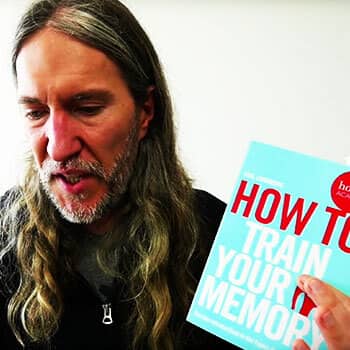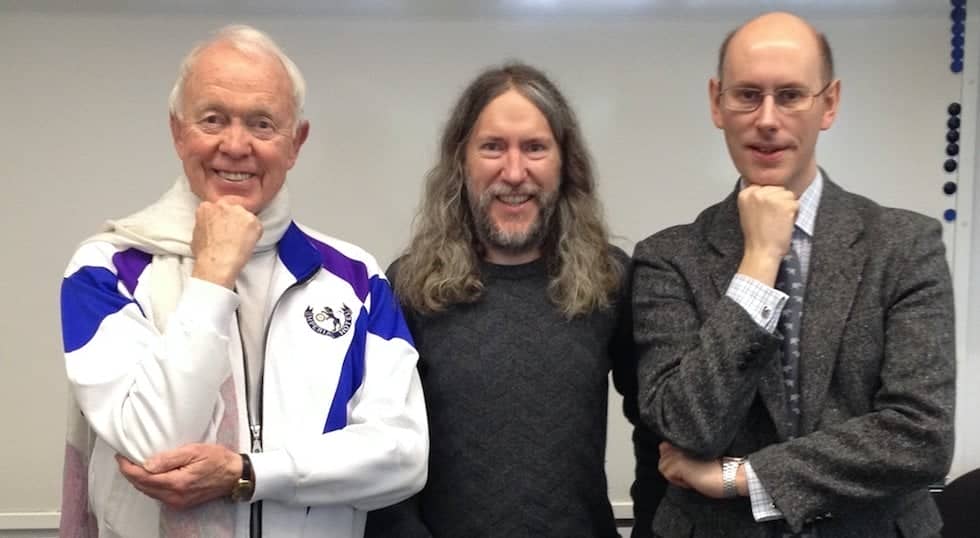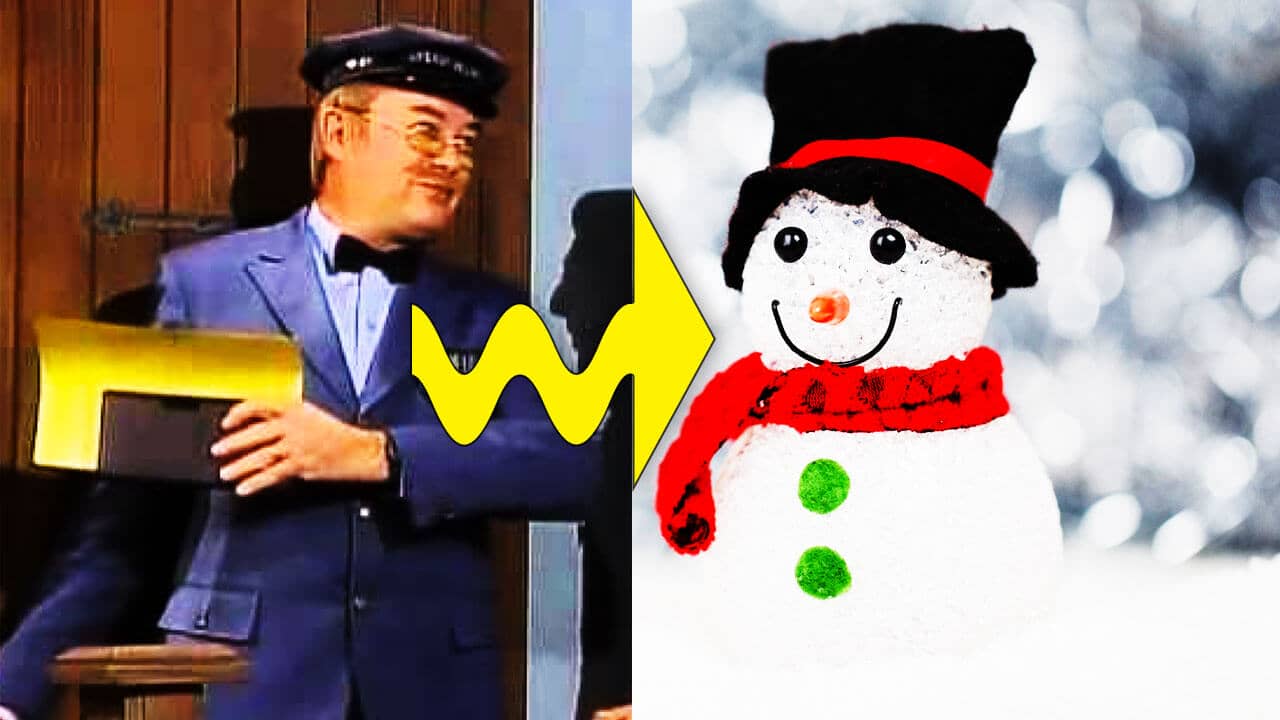Go offline with the Player FM app!
How To Train Your Memory By Phil Chambers [Memory Improvement Book Review]
Archived series ("Inactive feed" status)
When?
This feed was archived on February 19, 2024 00:56 (
Why? Inactive feed status. Our servers were unable to retrieve a valid podcast feed for a sustained period.
What now? You might be able to find a more up-to-date version using the search function. This series will no longer be checked for updates. If you believe this to be in error, please check if the publisher's feed link below is valid and contact support to request the feed be restored or if you have any other concerns about this.
Manage episode 218273970 series 1375140
 If you want to know how to train your memory, the journey to greatness begins with recognizing something odd about that brain between your ears:
If you want to know how to train your memory, the journey to greatness begins with recognizing something odd about that brain between your ears:
You sometimes forget enormous things!
That’s how Phil Chambers begins his fantastic book, How to Train Your Memory.
When you start your memory improvement journey by acknowledging just how easy it is to forget where you parked your car, you start from practical realities we all face.
After all, vehicles are the biggest things we own apart from our homes.
Yet, the location of a car can still easily disappear from memory!
Acknowledging this fact gives us a sense of just how strange and mysterious an entity you’re dealing with.
Of course, there’s something even bigger than cars and houses we forget that How To Train Your Memory helped me recognize, but we’ll get to that in just a bit.

First, let’s talk about:
Why You Should Learn How To Improve
Memory Recall From Memory Expert Phil Chambers
It’s a good question, and a delight to answer.
First off, Phil’s a great writer. When learning how to improve memory and concentration, clarity matters.
Second, Phil’s got street cred.
More than being a leading memory expert, he’s the Chief Arbiter of the World Memory Championships. We talked a few years ago about what this role involves in the interview called Phil Chambers and the Outer Limits of Memory.
Phil is also one of the few memory trainers who has thought deeply about combining Memory Palaces with Mind Maps. He is a World Mind Mapping Champion, after all, and author of the incredible guide, 101 Top Tips For Better Mind Maps.
https://youtu.be/VW6O2okqmO4
And if that wasn’t enough, get this:
Phil has taught memory improvement and mind mapping alongside Tony Buzan himself for many years. In fact, I made it a point to attend a live Thinkbuzan training and learned more than I ever would have dreamed possible.
Having them both in the same room is a blessing you won’t want to miss!
Why Memory Training Is The Best Way To Improve Memory And Concentration
I remember taking courses with the filmmakers Atom Egoyan and Peter Greenaway while studying at the European Graduate School.
Both of them have encyclopedia knowledge of Film History.
But because I know how to convert semantic memory into episodic memory, I listened to those lectures differently than my fellow students.
Sure, I took notes using my approach to note taking.
But using the same tools Phil talks about in How to Train Your Memory, I remembered tons of names and details simply because I was actively connecting imagery with the information as the professors spoke.
And I was able to do so even though I was star struck to be in the same seminar rooms with these legends of cinema.
Kind of like how I was star struck to be in a room with Phill and Tony!

In other words, using memory techniques help you zone in on details by using association that pushes away distractions.
Phil explains why and how association works. He also gives additional tips and examples that will help you. One skill in particular that you’ll get better at after reading this book is the one that matters the most:
The ability to convert abstract information into concrete images better and faster.
How does Phil’s book help you develop this skill?
Each chapter gives you exercises to complete.
And you really should complete them.
In fact, getting a physical copy of How To Train Your Memory will help make sure you complete the exercises. I talk about why I’ve been reading only from physical books for memory training here:
https://youtu.be/er-k8Ecgdfo
(Oh, and physical books make it easier to use the Major System to memorize page numbers so you can easily find good passages you want read again.)
When Acronyms For Learning Help Your Memory Excel &
When They Lead To Failure
One of my favorite parts of How to Train Your Memory is when Phil Chambers lays out the pros and cons on using acronyms for memory training.
Basically, it comes down to calculating the margin for error.
The same thing goes for using rhyming as a memory technique. Sure, it can work, but when using mnemonic devices, too many things can go wrong.
Why?
It comes back to the science of memory:
If you don’t convert semantic information into episodic memory through the use of mental imagery, you will find it harder to reproduce.
But there is one acronym that Phil gives us that demonstrates when this technique is super powerful, and I’d like to demonstrate how and why.

The acronym is SEAHORSE.
You’ll need to read the book to learn the memory training lessons packed into that single word, but when you get it right, you’ll have the keys to the memory improvement kingdom permanently locked into your mind.
The reason why this acronym works so well is that:
1. The mnemonic acronym SEAHORSE creates an image. You can picture the creature in your mind.
2. SEAHORSE creates an image that looks like a part of the brain that plays a huge role in memory.
This is the hippocampus, which is names in Greek after its resemblance to the animal. (Hippo = horse and kampos = sea monster).
3. You can connect the SEAHORSE acronym to the author himself when you realize that the name Phillip (i.e. Phil Chambers) relates to the word hippocampus.
How To Use A Mnemonic Acronym In A Memory Palace
As I’ve already shared, I’ve met Phil Chambers in a room. In fact, Phil and our group turned that room and its surrounding area into a Memory Palace.
Now I can use it again and see where Phil sat in the room. I can place the image of a Seahorse over his head to remember the acronym.
I can also place as a hippopotamus with a horse’s mane over his left shoulder and a camping tent over his right shoulder.
These images remind me of the Greek word origin of hippocampus. I am encoding both the sound and meanings of these words by converting facts into images.
These images automatically receive episodic memory characteristics.
This “transfer” happens because:
- There is a story behind why I was in that room.
- The stories I know about Phil
- The “image-story” of why a hippo would have a horse’s mane in the first place (it’s because the seahorse in his brain is driving him insane…)

This image-story takes just a few seconds to generate.
And yes, my brain is aided by the fact that I’ve met Phil and I’m drawing upon neurochemical changes.
This is why you should focus on drawing from your own experiences too. It’s related to the multi-sensory memory experiences fellow memory expert Nelson Dellis talks about in Remember It!
Then, by charting out 8 Magnetic Stations throughout the room, I can then layer on some Magnetic Imagery for the parts of the acronym itself.
For example, the first word of SEAHORSE is “Senses.” In the corner of the seminar room, I can see Superman. He is tasting his hearing aid while blind and suffering from a belly ache.
Why? Because a blind Superman tasting a hearing aid while in pain reminds me of most of the senses. I can even change his name to Super-Sense-Man to tap into the cognitive mode of the mind and memory and seal the deal.
All that needs to happen next is to move to the next station and create a memorable image for the acronym word that starts with “E.”
The Fullest History Of The Major System In The World
I’m a huge fan of the Major System and use it every day in the memory training I use based on memory training techniques from around the world. Even if it feels invisible, the Major (or Major Method) is actually behind the 00-99 I use for phone numbers, playing cards, birthdates and everything based on digits.
I learned a lot from reading Phil’s take on both the history of the Major and how he mixes it with the number-shape technique.
Why is the history of our tradition so important?
Easy:
Knowing the story of the memory tools you use gives you even more mental connections and imagery!
In terms of the actual technique, Phil points out something that I try to make sure everyone understands:
The techniques you use for competition are not necessarily the same as the ones you would use in every day life or for large learning projects.
Before I continue, let’s review the Major Method. There are some variations and different approaches to the Major System, but this arrangement is quite common:

Now, for many people learning how to memorize numbers, this approach will be more than enough for daily life. Except…
How do you deal with 3 digit numbers without creating a 000-999?
Phil demonstrates exactly how to do it in ways that I do all the time. For example, 358 would be the mail man based on the Major and a snowman based on the number-shape technique.
For me, 35 is the mail man Mr. McFeely from Mr. Rogers Neighborhood. So I just see him shoving envelopes into Frosty the Snowman.

However, here’s the problem:
In a competition setting, the context might tempt you to mix and match the Major with the number-shape technique and impoverish your results.
And that’s exactly what happened to me when Phil gave us a number memory test. I was half-using the Major and half-using the number-shape approach.
In real life, when you have time to review your images and re-shape them when needed, no big deal. But when the heat is on during a competition, there simply isn’t time. You are working at the level of practical strategy.
Both involve what Phil describes as “creative innovation.”
But in the case of competition, you need your mnemonic systems set up and well-practiced in advance for competition purposes. Learning life is usually – though not always – more forgiving.
Mind Maps For Memory Training & Memory Improvement?
One of my favorite parts of How to Train Your Memory involves the limitations mind mapping has for memory improvement.
Phil explains the ins-and-outs clearly and continues giving incredible tips.
And the best part is this:
The book includes a number of his own mind maps that explain the memory techniques taught in the book. It’s also a great supplement to Tony Buzan’s Mind Map Mastery.
In sum, Phil gives you a decision matrix for knowing when to use mind maps for memory and when to go to more dedicated techniques and strategies.
More and more, I’ve been thinking about what I’ve learned from him about mind mapping and often impose a “mnemonic clock” on the page built from the Major so that each position has a ready made image.
For example, 12 is Tin Tin, 13 (one-o-clock) is J. Edgar Hoover vacuuming the Hoover Damn with a Hoover vacuum, etc.
Although this approach is a bit rigid, as Tony Buzan said while I trained with this Dynamic Duo of memory improvement, “The Rules Will Set You Free.”
And as Phil makes clear, the context in which you choose the rules you will follow matters the most above all.
Why You Need To Read How To Train Your Memory
Memory training is a bit of an odd world.
On the one hand, there are many books you can read and be set for life. You just need to keep using the techniques you’ve learned.
On the other hand, there’s always more to learn and top performers in every field constantly revisit old ideas and scour the world for new angles.
Plus, we simply don’t know what we don’t know.
That’s why I’ve was delighted to re-experience some familiar concepts through a new lens in How To Train Your Memory and learn things I didn’t know before.
I highly recommend you do the same.
Oh, and about that issue with people forgetting things bigger than their car or their house.
It’s this:
People forget to pursue their passions.
That’s even stranger than forgetting where you parked.
And if your passion involves the need for better memory (how could it not?), make sure you read How To Train Your Memory by Phil Chambers.
500 episodes
Archived series ("Inactive feed" status)
When?
This feed was archived on February 19, 2024 00:56 (
Why? Inactive feed status. Our servers were unable to retrieve a valid podcast feed for a sustained period.
What now? You might be able to find a more up-to-date version using the search function. This series will no longer be checked for updates. If you believe this to be in error, please check if the publisher's feed link below is valid and contact support to request the feed be restored or if you have any other concerns about this.
Manage episode 218273970 series 1375140
 If you want to know how to train your memory, the journey to greatness begins with recognizing something odd about that brain between your ears:
If you want to know how to train your memory, the journey to greatness begins with recognizing something odd about that brain between your ears:
You sometimes forget enormous things!
That’s how Phil Chambers begins his fantastic book, How to Train Your Memory.
When you start your memory improvement journey by acknowledging just how easy it is to forget where you parked your car, you start from practical realities we all face.
After all, vehicles are the biggest things we own apart from our homes.
Yet, the location of a car can still easily disappear from memory!
Acknowledging this fact gives us a sense of just how strange and mysterious an entity you’re dealing with.
Of course, there’s something even bigger than cars and houses we forget that How To Train Your Memory helped me recognize, but we’ll get to that in just a bit.

First, let’s talk about:
Why You Should Learn How To Improve
Memory Recall From Memory Expert Phil Chambers
It’s a good question, and a delight to answer.
First off, Phil’s a great writer. When learning how to improve memory and concentration, clarity matters.
Second, Phil’s got street cred.
More than being a leading memory expert, he’s the Chief Arbiter of the World Memory Championships. We talked a few years ago about what this role involves in the interview called Phil Chambers and the Outer Limits of Memory.
Phil is also one of the few memory trainers who has thought deeply about combining Memory Palaces with Mind Maps. He is a World Mind Mapping Champion, after all, and author of the incredible guide, 101 Top Tips For Better Mind Maps.
https://youtu.be/VW6O2okqmO4
And if that wasn’t enough, get this:
Phil has taught memory improvement and mind mapping alongside Tony Buzan himself for many years. In fact, I made it a point to attend a live Thinkbuzan training and learned more than I ever would have dreamed possible.
Having them both in the same room is a blessing you won’t want to miss!
Why Memory Training Is The Best Way To Improve Memory And Concentration
I remember taking courses with the filmmakers Atom Egoyan and Peter Greenaway while studying at the European Graduate School.
Both of them have encyclopedia knowledge of Film History.
But because I know how to convert semantic memory into episodic memory, I listened to those lectures differently than my fellow students.
Sure, I took notes using my approach to note taking.
But using the same tools Phil talks about in How to Train Your Memory, I remembered tons of names and details simply because I was actively connecting imagery with the information as the professors spoke.
And I was able to do so even though I was star struck to be in the same seminar rooms with these legends of cinema.
Kind of like how I was star struck to be in a room with Phill and Tony!

In other words, using memory techniques help you zone in on details by using association that pushes away distractions.
Phil explains why and how association works. He also gives additional tips and examples that will help you. One skill in particular that you’ll get better at after reading this book is the one that matters the most:
The ability to convert abstract information into concrete images better and faster.
How does Phil’s book help you develop this skill?
Each chapter gives you exercises to complete.
And you really should complete them.
In fact, getting a physical copy of How To Train Your Memory will help make sure you complete the exercises. I talk about why I’ve been reading only from physical books for memory training here:
https://youtu.be/er-k8Ecgdfo
(Oh, and physical books make it easier to use the Major System to memorize page numbers so you can easily find good passages you want read again.)
When Acronyms For Learning Help Your Memory Excel &
When They Lead To Failure
One of my favorite parts of How to Train Your Memory is when Phil Chambers lays out the pros and cons on using acronyms for memory training.
Basically, it comes down to calculating the margin for error.
The same thing goes for using rhyming as a memory technique. Sure, it can work, but when using mnemonic devices, too many things can go wrong.
Why?
It comes back to the science of memory:
If you don’t convert semantic information into episodic memory through the use of mental imagery, you will find it harder to reproduce.
But there is one acronym that Phil gives us that demonstrates when this technique is super powerful, and I’d like to demonstrate how and why.

The acronym is SEAHORSE.
You’ll need to read the book to learn the memory training lessons packed into that single word, but when you get it right, you’ll have the keys to the memory improvement kingdom permanently locked into your mind.
The reason why this acronym works so well is that:
1. The mnemonic acronym SEAHORSE creates an image. You can picture the creature in your mind.
2. SEAHORSE creates an image that looks like a part of the brain that plays a huge role in memory.
This is the hippocampus, which is names in Greek after its resemblance to the animal. (Hippo = horse and kampos = sea monster).
3. You can connect the SEAHORSE acronym to the author himself when you realize that the name Phillip (i.e. Phil Chambers) relates to the word hippocampus.
How To Use A Mnemonic Acronym In A Memory Palace
As I’ve already shared, I’ve met Phil Chambers in a room. In fact, Phil and our group turned that room and its surrounding area into a Memory Palace.
Now I can use it again and see where Phil sat in the room. I can place the image of a Seahorse over his head to remember the acronym.
I can also place as a hippopotamus with a horse’s mane over his left shoulder and a camping tent over his right shoulder.
These images remind me of the Greek word origin of hippocampus. I am encoding both the sound and meanings of these words by converting facts into images.
These images automatically receive episodic memory characteristics.
This “transfer” happens because:
- There is a story behind why I was in that room.
- The stories I know about Phil
- The “image-story” of why a hippo would have a horse’s mane in the first place (it’s because the seahorse in his brain is driving him insane…)

This image-story takes just a few seconds to generate.
And yes, my brain is aided by the fact that I’ve met Phil and I’m drawing upon neurochemical changes.
This is why you should focus on drawing from your own experiences too. It’s related to the multi-sensory memory experiences fellow memory expert Nelson Dellis talks about in Remember It!
Then, by charting out 8 Magnetic Stations throughout the room, I can then layer on some Magnetic Imagery for the parts of the acronym itself.
For example, the first word of SEAHORSE is “Senses.” In the corner of the seminar room, I can see Superman. He is tasting his hearing aid while blind and suffering from a belly ache.
Why? Because a blind Superman tasting a hearing aid while in pain reminds me of most of the senses. I can even change his name to Super-Sense-Man to tap into the cognitive mode of the mind and memory and seal the deal.
All that needs to happen next is to move to the next station and create a memorable image for the acronym word that starts with “E.”
The Fullest History Of The Major System In The World
I’m a huge fan of the Major System and use it every day in the memory training I use based on memory training techniques from around the world. Even if it feels invisible, the Major (or Major Method) is actually behind the 00-99 I use for phone numbers, playing cards, birthdates and everything based on digits.
I learned a lot from reading Phil’s take on both the history of the Major and how he mixes it with the number-shape technique.
Why is the history of our tradition so important?
Easy:
Knowing the story of the memory tools you use gives you even more mental connections and imagery!
In terms of the actual technique, Phil points out something that I try to make sure everyone understands:
The techniques you use for competition are not necessarily the same as the ones you would use in every day life or for large learning projects.
Before I continue, let’s review the Major Method. There are some variations and different approaches to the Major System, but this arrangement is quite common:

Now, for many people learning how to memorize numbers, this approach will be more than enough for daily life. Except…
How do you deal with 3 digit numbers without creating a 000-999?
Phil demonstrates exactly how to do it in ways that I do all the time. For example, 358 would be the mail man based on the Major and a snowman based on the number-shape technique.
For me, 35 is the mail man Mr. McFeely from Mr. Rogers Neighborhood. So I just see him shoving envelopes into Frosty the Snowman.

However, here’s the problem:
In a competition setting, the context might tempt you to mix and match the Major with the number-shape technique and impoverish your results.
And that’s exactly what happened to me when Phil gave us a number memory test. I was half-using the Major and half-using the number-shape approach.
In real life, when you have time to review your images and re-shape them when needed, no big deal. But when the heat is on during a competition, there simply isn’t time. You are working at the level of practical strategy.
Both involve what Phil describes as “creative innovation.”
But in the case of competition, you need your mnemonic systems set up and well-practiced in advance for competition purposes. Learning life is usually – though not always – more forgiving.
Mind Maps For Memory Training & Memory Improvement?
One of my favorite parts of How to Train Your Memory involves the limitations mind mapping has for memory improvement.
Phil explains the ins-and-outs clearly and continues giving incredible tips.
And the best part is this:
The book includes a number of his own mind maps that explain the memory techniques taught in the book. It’s also a great supplement to Tony Buzan’s Mind Map Mastery.
In sum, Phil gives you a decision matrix for knowing when to use mind maps for memory and when to go to more dedicated techniques and strategies.
More and more, I’ve been thinking about what I’ve learned from him about mind mapping and often impose a “mnemonic clock” on the page built from the Major so that each position has a ready made image.
For example, 12 is Tin Tin, 13 (one-o-clock) is J. Edgar Hoover vacuuming the Hoover Damn with a Hoover vacuum, etc.
Although this approach is a bit rigid, as Tony Buzan said while I trained with this Dynamic Duo of memory improvement, “The Rules Will Set You Free.”
And as Phil makes clear, the context in which you choose the rules you will follow matters the most above all.
Why You Need To Read How To Train Your Memory
Memory training is a bit of an odd world.
On the one hand, there are many books you can read and be set for life. You just need to keep using the techniques you’ve learned.
On the other hand, there’s always more to learn and top performers in every field constantly revisit old ideas and scour the world for new angles.
Plus, we simply don’t know what we don’t know.
That’s why I’ve was delighted to re-experience some familiar concepts through a new lens in How To Train Your Memory and learn things I didn’t know before.
I highly recommend you do the same.
Oh, and about that issue with people forgetting things bigger than their car or their house.
It’s this:
People forget to pursue their passions.
That’s even stranger than forgetting where you parked.
And if your passion involves the need for better memory (how could it not?), make sure you read How To Train Your Memory by Phil Chambers.
500 episodes
Alle Folgen
×Welcome to Player FM!
Player FM is scanning the web for high-quality podcasts for you to enjoy right now. It's the best podcast app and works on Android, iPhone, and the web. Signup to sync subscriptions across devices.




